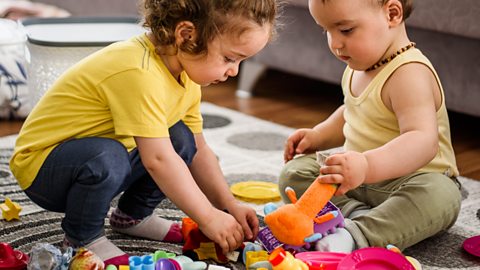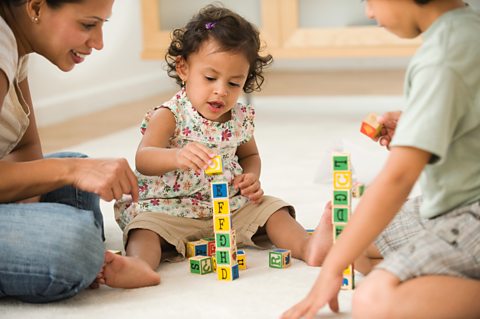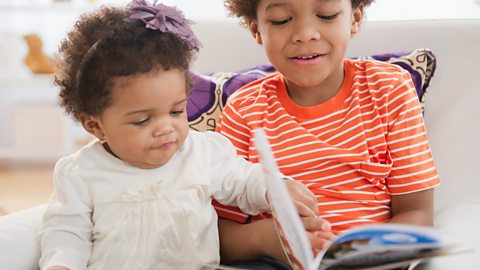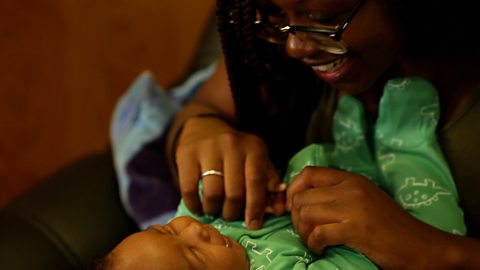
We know that having two or more young children can be tough, but it can also be really rewarding, especially if you can include older siblings in talking to baby.
This will help them bond with one another and feel less like theyŌĆÖre competing for grown-upsŌĆÖ time, which can mean less squabbling and an easier time for you (and who doesn't need that at the moment?). Plus, your baby will learn from hearing more people around them talk.
With this in mind, we spoke to Speech and Language Therapist, Francesca Ellis, to get her tips on involving bigger brothers and sisters.

Make them feel important

Try asking the older child to help with day-to-day tasks like fetching nappies.
This can help make the older sibling feel like theyŌĆÖre playing an important role for you and your baby.
Show them how you talk your baby through nappy changes or feeds, saying things in a sing-song voice like ŌĆśthis is a nappy ŌĆō a smelly nappy!ŌĆÖ. YouŌĆÖll hopefully find that they copy this and speak to the baby themselves next time, remembering how you did it.
Not only will your baby hear more language, it might also stop your older child feeling like they are competing for your attention.
Don't take it to heart if your eldest isn't always thrilled at the idea of changing nappies or warming bottles. But if you can convince them to take part, all three of you can benefit.
Let baby watch them play

When an older child is playing with toys, itŌĆÖs nice to have your baby sit near to them.
Babies can learn a lot just by watching other children play.
At playtime, toddlers will often natter to themselves and their toys, just like theyŌĆÖve heard grown-ups speak to them. This is particularly true when playing with dolls and teddies, as they copy the sing-song voice their parents use with them.
If their younger brother or sister is sat nearby hearing this, it will add to the amount of baby talk theyŌĆÖre hearing. And in time their older sibling might even include them in their play, which is always lovely to see!
Encourage them to take turns

Now, you might be thinking ŌĆśhow on earth can you expect a baby to take turns?ŌĆÖ, but itŌĆÖs important to show them how turn-taking works as early as possible.
One way to do this is by building it into play. For example, you might get siblings to stack cups or bricks together, using their names and telling each child when itŌĆÖs their turn.
Your baby isnŌĆÖt going to properly understand whatŌĆÖs expected, so you will have to hold them and stop them from ruining it. But you are introducing them to the rhythm of back and forth interaction.
By making the older sibling wait their turn in play, youŌĆÖll get them used to the idea when it comes to conversation. So the next time youŌĆÖre babbling with baby at the dinner table, you can let the older child know it's baby's turn to talk.
Get them reading to baby

If thereŌĆÖs a slightly bigger gap between children, encourage the older child to do their reading practice with their younger sibling.
Try having them read a bedtime story to their baby brother/sister so that their homework has a double benefit.
When children first start reading, thereŌĆÖs often a bit of a mismatch between the sorts of stories they love to hear and their own ability to read. For this reason, a lot of kids find it difficult to get into reading when they can only read simple books.
However, this might change if they feel like theyŌĆÖre reading for the babyŌĆÖs entertainment.
How do you get your older children involved in your baby's development?
We asked you for your ideas and experiencesŌĆ”
ŌĆ£My seven-year-old boy reads to my twin girls and plays with them every day showing them colours and shapes. Their bond is so special!ŌĆØ
ŌĆ£Get your older children involved in helping dress their baby brother and sister. You can also ask them to get wipes and nappies ready when itŌĆÖs changing time. We gave our middle son a dolly of his own when his baby sister was born so he could practice with that.ŌĆØ
ŌĆ£There is a seven-year age gap with my two. My eldest helped feed, change and dress his brother. He would hold him in the morning and watch him in his bouncy chair in my bedroom while I got dressed.ŌĆØ
ŌĆ£My three-year-old daughter loves having her baby sister sit on her lap (with help), she loves singing to her and giving her toys!ŌĆØ
ŌĆ£I did things like put my two in the bath together and encourage my oldest boy to tell his brother a story. It was also important to talk to him about how much his baby brother looks up to him and loves him. I reminded him about when he was a baby by looking at his baby pictures together. It really helped boost his confidence.ŌĆØ
ŌĆ£When my oldest was turning three, she became a big sister and she helped with everything from changing her baby sister to introducing people to her when we got home. She was amazing and they now have a strong bondŌĆ” despite the fighting!ŌĆØ
ŌĆ£My older kids are obsessed with making their baby sister giggle. She loves watching them dance, so they happily do it for her.ŌĆØ
ŌĆ£I found that baby yoga is brilliant for getting siblings involved. Your older child can help bounce babyŌĆÖs legs and stretch them out, which is great for motor skills and helps bonding too.ŌĆØ
ŌĆ£IŌĆÖve created a list of activities we can do at home, including dancing to rhymes and playing with rice and jelly. My eldest then chooses two or more tasks to do with her baby sister every week. SheŌĆÖs loving it! The responsibility and freedom to decide the activities have made it interesting for her and sheŌĆÖs told all our family about it.ŌĆØ






